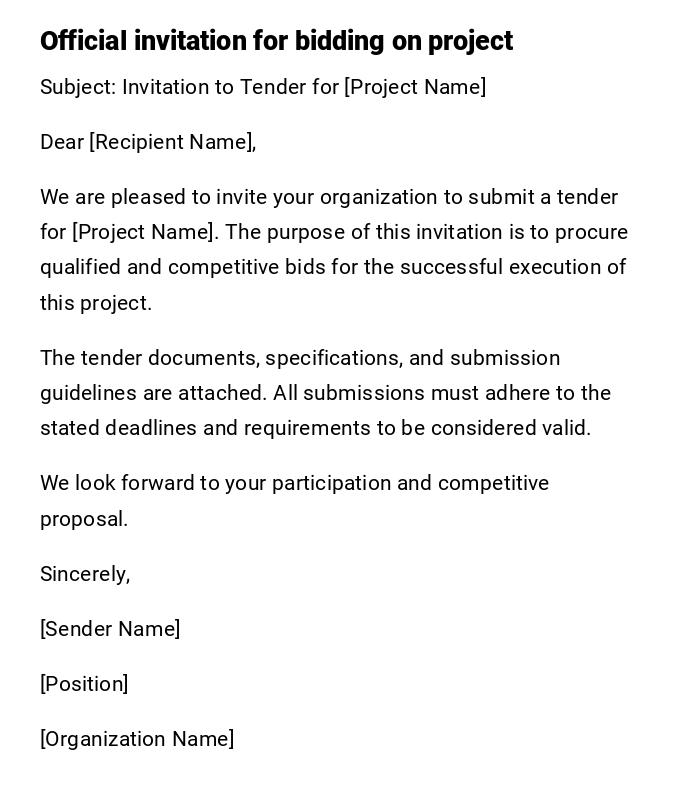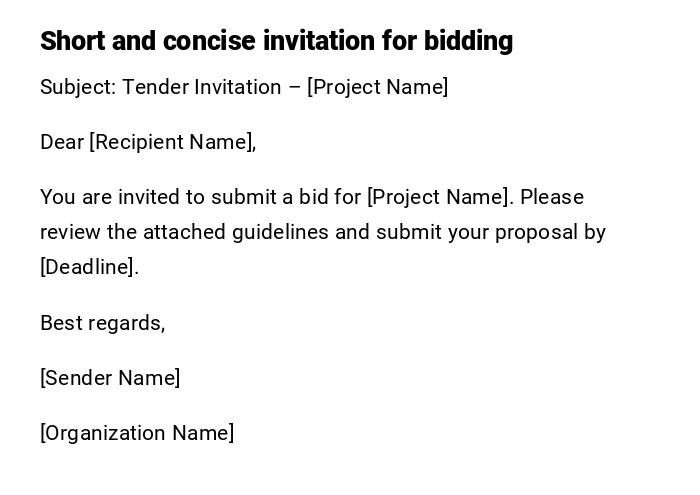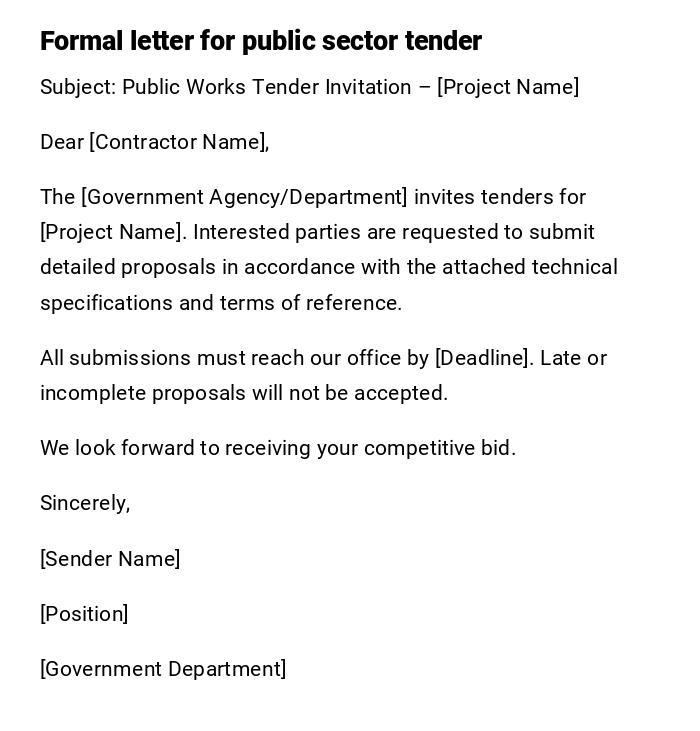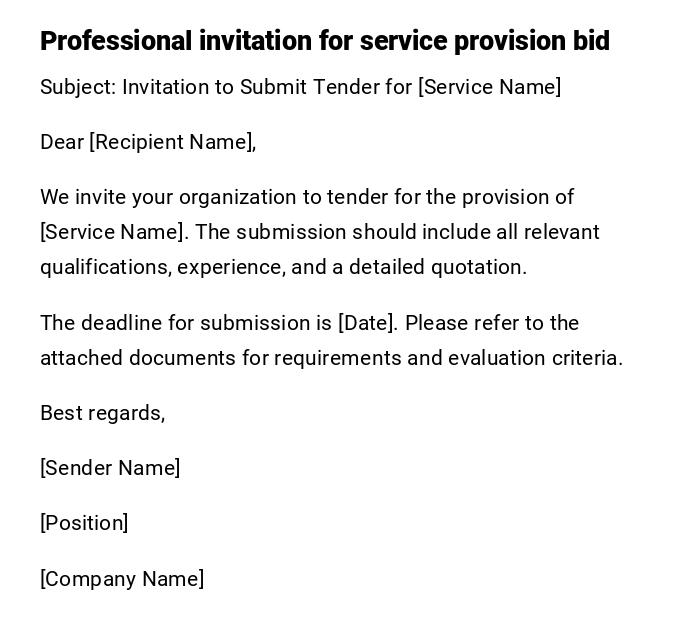Invitation To Tender Or Bid Letter
[Your Company's Name]
[Your Company's Address]
[City, State, ZIP Code]
[Date]
[Recipient's Name]
[Recipient's Title]
[Recipient's Company]
[Recipient's Address]
[City, State, ZIP Code]
Subject: Invitation to Tender/Bid for [Project/Contract Name]
Dear [Recipient's Name],
We hope this letter finds you well. On behalf of [Your Company's Name], we are pleased to extend this formal invitation to tender/bid for the [Project/Contract Name].
[Description of Project/Contract]:
Provide a concise overview of the project or contract for which the tender/bid is being invited. Include the key objectives, scope of work, deliverables, timelines, and any specific requirements or criteria that should be addressed in the submitted bids.
[Tender/Bid Submission Details]:
Include the following information regarding the tender/bid submission process:
1. Deadline: Clearly specify the deadline for submission of the tender/bid. Ensure that interested parties have sufficient time to prepare their proposals.
2. Submission Format: State the required format for the tender/bid submission, such as physical copies, electronic submissions, or both.
3. Contact Person: Provide the name, title, email address, and phone number of the person to whom inquiries regarding the tender/bid should be directed.
4. Site Visits or Pre-Bid Meetings: If applicable, indicate whether there will be any site visits or pre-bid meetings, and provide details about the date, time, and location of such events.
[Selection Criteria]:
Briefly outline the main evaluation criteria that will be used to assess the submitted tenders/bids. This may include factors such as price, experience, qualifications, technical approach, and any other relevant criteria.
[Confidentiality]:
Emphasize the importance of maintaining the confidentiality of all information shared during the tender/bid process and request that all bidders treat the process and associated documentation with utmost confidentiality.
[Additional Information]:
Include any other relevant information or specific requirements that bidders should be aware of before preparing and submitting their proposals.
We look forward to receiving your competitive tender/bid and believe that your expertise and experience will be invaluable to the successful completion of this project. Should you have any questions or require further clarification, please do not hesitate to contact our team at [Your Contact Email] or [Your Contact Phone Number].
Thank you for considering our invitation to tender/bid. We anticipate a fruitful partnership and eagerly await your response.
Sincerely,
[Your Name]
[Your Title]
[Your Company's Name]
Formal Invitation to Tender Letter
Subject: Invitation to Tender for [Project Name]
Dear [Recipient Name],
We are pleased to invite your organization to submit a tender for [Project Name]. The purpose of this invitation is to procure qualified and competitive bids for the successful execution of this project.
The tender documents, specifications, and submission guidelines are attached. All submissions must adhere to the stated deadlines and requirements to be considered valid.
We look forward to your participation and competitive proposal.
Sincerely,
[Sender Name]
[Position]
[Organization Name]
Email Invitation to Bid for Supply Contract
Subject: Invitation to Bid – [Supply Contract Name]
Dear [Recipient Name],
Our company is seeking bids for the supply of [Goods/Services]. You are hereby invited to participate in the bidding process and submit your proposal in accordance with the attached guidelines.
Please ensure your submission includes all required documents and adheres to the submission deadline of [Date]. Late submissions will not be accepted.
Thank you for your interest, and we look forward to receiving your bid.
Best regards,
[Sender Name]
[Position]
[Company Name]
Provisional Invitation to Tender
Subject: Provisional Tender Invitation – [Project Name]
Dear [Recipient Name],
We are issuing a provisional invitation for your organization to tender for [Project Name]. This notice is intended to gauge initial interest and collect preliminary proposals before the formal tender process.
Detailed documents and guidelines will follow upon confirmation of participation. We encourage early expression of interest by [Date].
Regards,
[Sender Name]
[Position]
[Organization Name]
Quick Invitation to Tender Letter
Subject: Tender Invitation – [Project Name]
Dear [Recipient Name],
You are invited to submit a bid for [Project Name]. Please review the attached guidelines and submit your proposal by [Deadline].
Best regards,
[Sender Name]
[Organization Name]
Invitation to Tender for Public Works Project
Subject: Public Works Tender Invitation – [Project Name]
Dear [Contractor Name],
The [Government Agency/Department] invites tenders for [Project Name]. Interested parties are requested to submit detailed proposals in accordance with the attached technical specifications and terms of reference.
All submissions must reach our office by [Deadline]. Late or incomplete proposals will not be accepted.
We look forward to receiving your competitive bid.
Sincerely,
[Sender Name]
[Position]
[Government Department]
Invitation to Tender for Service Contract
Subject: Invitation to Submit Tender for [Service Name]
Dear [Recipient Name],
We invite your organization to tender for the provision of [Service Name]. The submission should include all relevant qualifications, experience, and a detailed quotation.
The deadline for submission is [Date]. Please refer to the attached documents for requirements and evaluation criteria.
Best regards,
[Sender Name]
[Position]
[Company Name]
Informal Email Invitation to Bid
Subject: Invitation to Bid – [Project Name]
Hello [Recipient Name],
We would like to invite your company to bid for [Project Name]. Attached are the guidelines and requirements. Please send your proposal by [Date].
Thanks and looking forward to your submission.
Best,
[Sender Name]
What is an Invitation to Tender or Bid Letter and Why It Is Used
An Invitation to Tender (ITT) or Bid Letter is a formal communication issued by an organization or company inviting suppliers, contractors, or service providers to submit proposals for a specific project or service.
Purpose:
- Procure competitive bids.
- Ensure transparency and fairness in selection.
- Gather qualified proposals from interested parties.
- Establish terms, deadlines, and submission requirements.
Who Should Issue an Invitation to Tender
- Authorized personnel within the organization or company.
- Project managers or procurement officers.
- Department heads in charge of contracting or purchasing.
- Government agencies or public sector authorities for public tenders.
To Whom Should an Invitation to Tender Be Addressed
- Registered suppliers, contractors, or service providers.
- Vendors with relevant experience or qualifications.
- Interested parties who have expressed prior interest.
- Potential bidders for public sector or specialized projects.
When to Send an Invitation to Tender
- At the start of a procurement process for a project or service.
- When multiple qualified bidders need to be invited to ensure competitiveness.
- Prior to the deadline for budget planning or project timelines.
- For periodic service contracts requiring renewal or competitive quotes.
How to Prepare and Send a Tender Invitation
- Identify the scope and requirements of the project or service.
- Prepare detailed tender documents including specifications, terms, and conditions.
- Decide the format and mode of sending (email, post, or electronic tender platform).
- Include clear submission deadlines and contact information for queries.
- Issue the invitation with proper authorization and record keeping.
Requirements and Prerequisites Before Sending an Invitation
- Approval from management or relevant authority.
- Comprehensive project details, specifications, and evaluation criteria.
- List of potential bidders or suppliers to invite.
- Clear timeline and submission process.
- Legal or regulatory compliance checks for public projects.
Formatting and Tone Guidelines
- Length: Usually one to two pages with attachments for details.
- Tone: Professional, formal, and unambiguous.
- Style: Clear headings, bullet points for requirements, and numbered sections.
- Mode: Printed letter, PDF, or email depending on recipient preference.
- Etiquette: Courteous, precise, and informative.
Common Mistakes to Avoid
- Sending incomplete or unclear tender requirements.
- Missing submission deadlines in communication.
- Addressing the wrong recipients or unqualified bidders.
- Using overly casual language for formal tenders.
- Failing to attach necessary documents or forms.
Elements and Structure of a Tender Invitation Letter
- Subject line clearly stating "Invitation to Tender" or "Invitation to Bid".
- Introduction of the sender and purpose of the letter.
- Scope and description of project or service.
- Submission requirements and deadlines.
- Evaluation criteria and legal conditions.
- Contact information for queries.
- Closing with signature and authority designation.
- Attachments: Tender documents, specifications, terms, forms.
After Sending the Invitation – Follow-Up Actions
- Track submissions and ensure receipt confirmation.
- Respond to queries from potential bidders promptly.
- Organize received tenders and prepare for evaluation.
- Keep detailed records for transparency and audit purposes.
Tricks and Tips for Effective Tender Invitations
- Provide clear instructions to avoid incomplete submissions.
- Use bullet points and headings for readability.
- Allow sufficient time for bidders to prepare proposals.
- Include contact info for clarifications.
- Keep all communications professional and documented.
Pros and Cons of Sending a Tender Invitation Letter
Pros:
- Ensures competitive pricing and quality.
- Maintains transparency and fairness in procurement.
- Allows evaluation of multiple options before selection.
Cons:
- Time-intensive preparation and management.
- Risk of receiving insufficient or non-compliant bids.
- May require follow-up to clarify bidder queries.
Compare and Contrast with Other Procurement Methods
- Direct Negotiation vs. Tender: Direct negotiation is faster but less competitive; tender ensures multiple competitive offers.
- Request for Quotation (RFQ) vs. Tender: RFQs are simpler and for smaller contracts; tenders are detailed and for larger, complex projects.
- Electronic Tender Platforms vs. Paper Invitations: Electronic platforms improve efficiency, tracking, and transparency; paper letters remain formal and traditional.









 Download Word Doc
Download Word Doc
 Download PDF
Download PDF